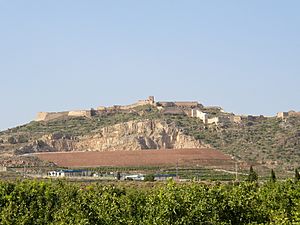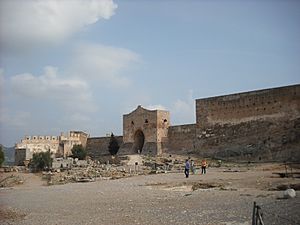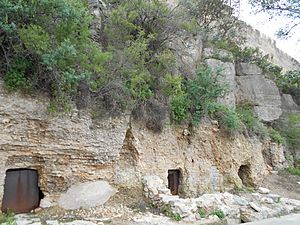Sagunto Castle facts for kids
Quick facts for kids Sagunto Castle |
|
|---|---|
| Near Sagunto in Spain | |
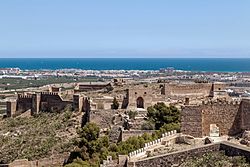
View across the walls of Sagunto Castle
|
|
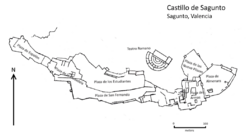
Map of the castle
|
|
| Coordinates | 39°40′33″N 0°16′39″W / 39.6757°N 0.2774°W |
| Type | Castle |
Sagunto Castle (which is Castillo de Sagunto in Spanish and Castell de Sagunt in Valencian) is a huge fortress. It stands high above the town of Sagunto, close to Valencia in Spain. This amazing castle has a history of over 2,000 years! People from different times, like the Iberians, Romans, and people from the Middle Ages, all left their mark here.
During the time when Muslims ruled parts of Spain, the castle was known by names like Murbĩtar and Morvedre. Because of its long and important history, the castle was named a National Monument in 1931. A famous general named Hannibal attacked the town in 219 BC. This attack helped start a big war called the Second Punic War. Most of the walls you see today were built during the Islamic period. They were later made even stronger and more modern after Christian rulers took over. In 1811, during the Napoleonic Wars, French soldiers attacked the castle. They eventually captured it, and then they repaired its defenses.
Contents
Where is Sagunto Castle Located?
Sagunto Castle is found about 23 kilometers (14 miles) north of Valencia. It sits on a flat-topped hill. This hill is the last part of the Sierra Calderona mountains. It reaches a height of 172 meters (564 feet) above sea level. This high spot gives the castle a great view of the area.
What is Sagunto Castle Like?
The castle is built on a hilltop that looks out over the Mediterranean Sea. Strong defensive walls surround the entire castle. The castle is split into seven main areas, or "plazas." These include the Plaza de Armas, Plaza de Almenara, Plaza de los Nueve Pilares, Plaza de San Fernando, Plaza de los Estudiantes, Plaza de la Ciudadela, and Plaza del Espolón. The ruins you see today are mostly from the Muslim fortress. Later, Christians and then French engineers during the Peninsular War made changes to it.
The Outer Walls
Most of the outer walls, called the curtain wall, were built during the Islamic period. These walls went down from the castle to connect with other forts around the town below. Many changes were made to these walls from the Christian period up to the Peninsular War. This included adding Gothic and Renaissance styles to the Muslim defenses. Several towers and strong bastions are still standing. Most of these were built in the 18th century.
Plaza del Refectorio
The Plaza del Refectorio is the smallest of the castle's plazas. It is in the middle of the castle, on a raised area. This area also holds the Reina Gobernadora battery. The Plaza del Refectorio gets its name from some arched rooms that were used as dining halls, or refectories. A building with these dining halls forms its east side. The south side has the outer wall, and the west side has a ruined double wall and a Roman tower. A fortified wall is on the north side. A path connects the Plaza del Refectorio and the battery, linking the Plaza de Armas with the Plaza de San Fernando.
Ancient Roman Parts of the Castle
You can enter the Plaza de Armas through an Islamic arch. On the east side of the castle, you can still see parts of the old Iberian defensive wall. The foundations of the Roman forum are also here. This was a public square in Roman times. You can also see parts of some Iberian buildings and a Roman temple. These are all located in the forum area on the hilltop. The Roman buildings were built around a square that was 60 by 36.5 meters (197 by 120 feet).
On the west side of the square was a large building called a basilica, which was 60 by 20 meters (197 by 66 feet). The east side of the square had a row of shops, known as tabernae. To the south of the square is a well-preserved water tank, called a cistern. The base of the temple is on the north side. This temple was 14 by 12 meters (46 by 39 feet). Another complex building was on the northeast side. We are not sure what it was, but it might have been a curia (a meeting hall or court) or a temple dedicated to Augustus. It had two large rooms, so it might have been used for both. The remains of a Roman theater are about 50 meters (160 feet) down the hillside, to the northwest of the forum. The cistern was probably built after the city was rebuilt following the Second Punic War.
The Roman forum was dug up by archaeologists in 1985. The first forum was built during the Late Republican period. It was mostly taken down in the early Imperial period to build a new one. The new forum was built when Augustus was emperor. A local rich person, Gnaeus Baebius Geminus, paid for it. The hilltop was made flat, and strong walls with supports were built to hold up the artificial platform for the forum. On the north side of the forum, you can still see these retaining walls and supports.
A Look at Sagunto Castle's History
It seems that the first people to live on this site were the Iberians. This was in the early Iron Age. These early people belonged to a tribe called the Edetani. As the Carthaginian Empire grew, the people of Sagunto made a defense agreement with Rome. The Carthaginian general Hannibal attacked the Iberian settlement in 219 BC. This event led to the start of the Second Punic War. In 214 BC, the Romans took Sagunto from the Carthaginians.
Between 175 and 100 BC, the Romans built a temple on the hill. A water cistern was built near the temple. This cistern was later made part of the Imperial forum in the 1st century AD. We don't know much about the castle's history during the Islamic period. During this time, Sagunto was not as important as Valencia. The Albacar part of the castle and most of the outer wall were built during the Islamic period. Arab records from the 8th century show that Sagunto was part of the area controlled by Tortosa, not Valencia, at that time.
A Muslim historian named Ibn Hayyan wrote that the castle was captured in 929–930. He also mentioned it again, by its Arab name, as giving up to the sultan Abd-ar-Rahman III in 933 AD. Sagunto Castle was used by the Muslims as a fortress to protect the regions of Catalonia and Valencia. El Cid, a famous Spanish warrior, captured and held it from 1098 to 1102. The Christian king Jaume I finally took it from Muslim rule in 1238. He then made it part of the Kingdom of Valencia. By the mid-13th century, Christian soldiers guarded the castle. However, most of the town's people were still Muslims.
By the early 14th century, Sagunto (still called Morvedre) had a growing Jewish population. This led to the creation of a Jewish cemetery under the castle walls in 1328. Peter IV of Aragon made the castle defenses stronger in the 14th century. In 1363, King Peter of Castile captured the castle after attacking it. In 1562, King Philip II of Spain asked Juan Bautista Antonelli to improve the castle's defenses. It was at this time that the castle area was divided into seven plazas.
During the War of the Spanish Succession in the early 18th century, the castle was given to the Archduke of Austria. But soon after, it came under the control of King Philip V of Spain. In 1811, during the Peninsular War, Brigadier Andriani defended the castle against French troops. These troops were led by General Suchet. They started attacking the fortress on September 23 of that year. Andriani fought off the attack and several assaults. However, Suchet eventually won. After taking the castle, Suchet ordered it to be repaired and its defenses strengthened. Andriani himself oversaw these changes.
In 1932, M. González Simancas dug up the area where the Roman ruins are in the Plaza de Armas. However, he left very few records of what he found.
See also
 In Spanish: Castillo de Sagunto para niños
In Spanish: Castillo de Sagunto para niños



